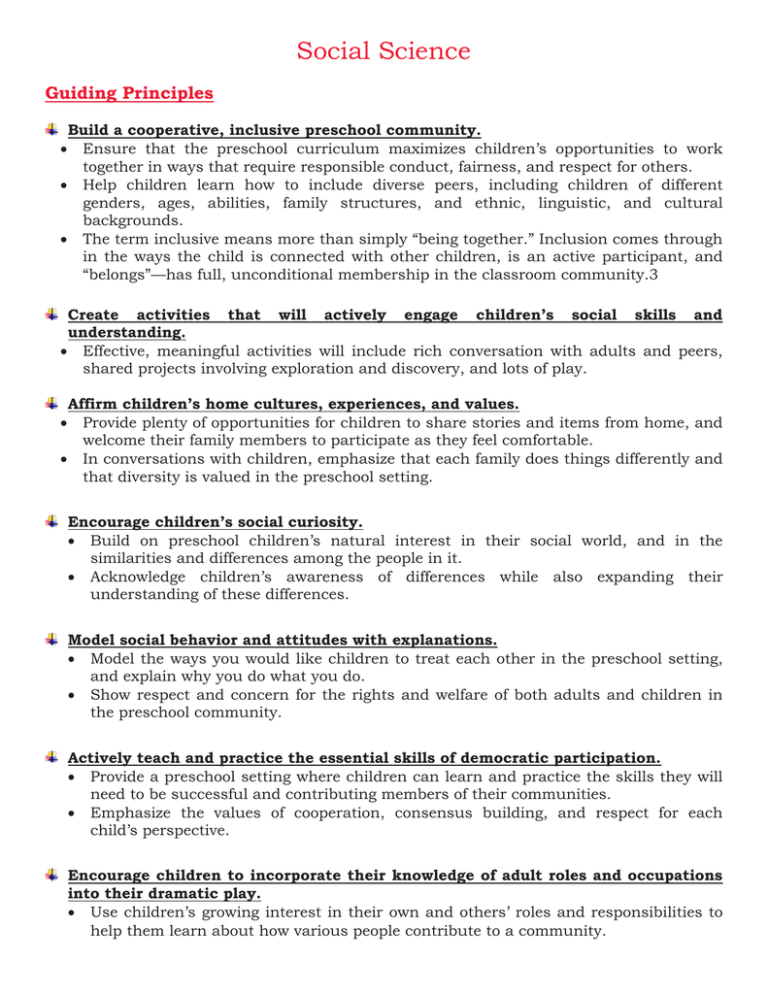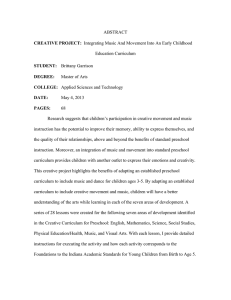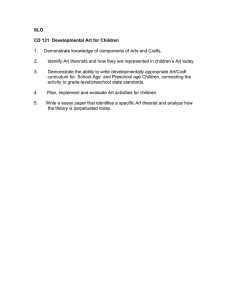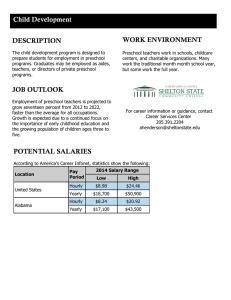Social Science-CA Dept of Education.docx
advertisement

Social Science Guiding Principles Build a cooperative, inclusive preschool community. Ensure that the preschool curriculum maximizes children’s opportunities to work together in ways that require responsible conduct, fairness, and respect for others. Help children learn how to include diverse peers, including children of different genders, ages, abilities, family structures, and ethnic, linguistic, and cultural backgrounds. The term inclusive means more than simply “being together.” Inclusion comes through in the ways the child is connected with other children, is an active participant, and “belongs”—has full, unconditional membership in the classroom community.3 Create activities that will actively engage children’s social skills and understanding. Effective, meaningful activities will include rich conversation with adults and peers, shared projects involving exploration and discovery, and lots of play. Affirm children’s home cultures, experiences, and values. Provide plenty of opportunities for children to share stories and items from home, and welcome their family members to participate as they feel comfortable. In conversations with children, emphasize that each family does things differently and that diversity is valued in the preschool setting. Encourage children’s social curiosity. Build on preschool children’s natural interest in their social world, and in the similarities and differences among the people in it. Acknowledge children’s awareness of differences while also expanding their understanding of these differences. Model social behavior and attitudes with explanations. Model the ways you would like children to treat each other in the preschool setting, and explain why you do what you do. Show respect and concern for the rights and welfare of both adults and children in the preschool community. Actively teach and practice the essential skills of democratic participation. Provide a preschool setting where children can learn and practice the skills they will need to be successful and contributing members of their communities. Emphasize the values of cooperation, consensus building, and respect for each child’s perspective. Encourage children to incorporate their knowledge of adult roles and occupations into their dramatic play. Use children’s growing interest in their own and others’ roles and responsibilities to help them learn about how various people contribute to a community. Observe and converse with children during play in order to learn about their current understanding of time and history. Focus on children as they communicate about and act out past, present, and future experiences, as well as family stories and broader historical events. Use this information to shape future curriculum plans. Help children deepen their own sense of place. Help children begin to understand and reflect on their sense of belonging in places and locations that are meaningful to them. Nurture children’s sense of wonder about nature. Observe preschool children’s engagement with the natural world, and encourage their protective feelings toward it. Environments and Materials When planning an environment to support children’s learning in history– social science, effective teachers consider the physical, curricular, and social elements. The physical environment and daily routine set the stage for children’s inquiry and should include ample time for children’s self-initiated work, different spaces for solitary play and for collaborative play, and engaging materials that children are encouraged to use creatively. The curricular plan needs to provide opportunities and adult support for both group learning and for informal discovery and skill development. The key to a positive social environment is a teacher who actively models curiosity, openness, and engagement and who is eager to explore the world together with children. An environment that supports children’s learning in history and the social sciences has the following characteristics: Extended projects that are centered on a topic in history or social science and emerge from children’s interests and inquiries There are multiple opportunities for children to actively engage with subject matter (e.g., learning about group decision making or caring for the earth) in meaningful and familiar contexts. Adults prepare for individual investigations as well as small-and large-group explorations. Reflective of diversity As opposed to a tourist approach, teachers and children participate in authentic experiences with culture. They routinely sing songs and read stories from different cultures. Adults engage children in meaningful conversations about daily life, highlighting diverse perspectives and experiences. Photographs, artwork, and music are representative of the children and families in the group, including children with disabilities. The dramatic play area is supplied with multicultural cooking tools, adaptive utensils, empty food containers, clothing, and other items reflective of the children’s homes. A balance between child choice and adult direction The daily routine supports both child-initiated play (“What’s your plan for work time? Where will you play today?”) and teacher-initiated learning experiences. Choice time offers children an opportunity to exercise creative freedom and decision making. Adults also initiate activities that support community participation and follow in order (“First we will sing songs as a group, and then we will have A variety of materials to support children’s inquiry-based learning and practice in the skills of social science Open-ended materials (e.g., sand and water, blocks) encourage children’s creative and divergent thinking. Paper, writing instruments, tallying tools, maps, charts, and other visual aids stimulate children to generate questions, collect information, summarize what they have learned, and form conclusions. Materials that connect children to times and places Program materials include authentic objects (e.g., loom) and cultural artifacts (e.g., handwoven blanket) to encourage children’s questions and active interest. Maps are displayed at the children’s eye level. Real experiences with nature and other environmental education materials Children have frequent access to an outdoor learning environment that is natureoriented; ideally, it includes trees, plants, grasses, and other living things. The indoor learning environment is supplied with pictures, puzzles, toy animals, books, and other play materials to facilitate inquiry and introduce children to less familiar ecosystems. The care of living creatures, such as preschool program pets, is also a part of the program curriculum. Tools and practices for appreciating and caring for the earth and its resources Systems are in place to introduce the concept of “Reduce, Reuse, Recycle” (“It looks like you are all done with that piece of paper for your project. Let’s put it in the recycling bin”). Materials are properly cared for, repurposed (e.g., paper is used on both sides), and shared across programs. Consumables are used as sparingly as possible. Display of children’s work and experiences Children’s investigations are highlighted using photographs, child-created pictures and maps, dictation, and models. Displays are positioned at children’s eye level. Dramatic play props and materials that represent firsthand experience with social roles and occupations, as well as consumer actions The room provides an ample supply of clothes for dress-up, items from a variety of work settings, play money, and other real objects (e.g., a telephone) and print artifacts (e.g., a restaurant menu). The room intentionally incorporates play props for exploring themes in multiple learning areas (e.g., transportation in the block area). High-quality children’s books with content related to self, family, and community The preschool program introduces shared-book reading and discussions about book content to facilitate an understanding of human behavior and relationships. Books are selected and rotated based on emerging themes to expand children’s awareness of people, places, and time. Books reflect the background and experiences of children in the group, including those with special needs, as well as those that extend beyond familiar homes and communities. Extension of learning into the local community to help children learn in the “here and now” of the world around them The program makes use of familiar contexts to permit successful explorations of self, family, and community, as children are able to draw from prior knowledge and experience. Plans are developed for fieldwork, such as visiting a local business or greeting the neighborhood postal worker, to expand learning beyond the classroom walls. If field trips are not practical, every effort is made to bring parts of the community into the setting via pictures, visitors, and props. Family involvement in program planning The environment and its materials demonstrate a partnership with families and are inclusive of community goals and values. Summary of the History– Social Science Foundations Self and Society The Self and Society foundations focus on young children’s growing ability to see themselves within the context of society. Culture and society concerns preschoolers’ growing interest in differences in culture, language, racial identity, abilities, and family traditions that are different from the child’s own.4 The preschool setting is a place where children explore differences and think about the messages they receive from society, the values they learn in their homes, and their own ideas about people. Relationships focuses on how young children develop skills in creating and maintaining close relationships, including recognizing the mutual responsibilities of relationships.5 Social roles and occupations describes children’s growing interest in and understanding of adult activities, including work and family roles.6 Becoming a Preschool Community Member (Civics) The Preschool Community Member foundations are concerned with how young children become responsible and cooperative members of the preschool community.7 Skills for democratic participation focuses on developing abilities to respect others’ opinions and preferences, participate in group activities and decision making, and balance personal goals with the goals of others. Responsible conduct focuses on developing self-regulation of behavior in accord with group expectations and rules.8 Fairness and respect for other people describes developing sensitivity to the feelings and needs of others through cooperation and helpfulness, and developing consideration of fairness for all.9 Conflict resolution focuses on young children’s growing skill in managing conflict through bargaining and compromise.10 Sense of Time (History) These foundations focus on developing understanding of past and future events and their association with the present.11 Understanding past events describes children’s developing ability to remember past events, the connection to other events of the past, and the connection to current experience. Anticipating and planning future events focuses on the ability to anticipate events in the near future and to make choices that prepare for future needs.12 Personal history is concerned with young children’s sense of their own growth and experiences. Historical changes in people and the world relates to children’s efforts to create a mental timeline in which events of the past are properly sequenced, including family history. 13 Sense of Place (Geography and Ecology) These foundations focus on developing knowledge of the physical settings in which children live and how they compare with other locations.14 Navigating familiar locations describes developing skills in understanding the characteristics and activities associated with familiar locations (such as home and school), the routes between them, and broader features of the natural environment such as hills and streams and weather patterns. Caring for the natural world concerns preschoolers’ expanding awareness of human–environment interaction, which is the basis for interest in taking care of plants and animals, knowledge of hazards such as pollution and litter, and an interest in natural environments that are different from their own. 15 Understanding the physical world through drawings and maps describes young children’s growth in representing the physical world through their own drawings or by interpreting simple maps.16 Marketplace (Economics) Foundation Preschoolers are curious and observant about the world of commerce, including the association between work and income, and purchasing. The single foundation, Exchange, describes young children’s developing understanding of economic concepts, including the ideas of ownership, money exchanged for goods and services, value and cost, and bartering.17 Summary of the Strands and Substrands The foundations of this section are organized according to the following strands and substrands: Self and Society Culture and Diversity Relationships Social Roles and Occupations Becoming a Preschool Community Member (Civics) Skills for Democratic Participation Responsible Conduct Fairness and Respect for Other People Conflict Resolution Sense of Time (History) Understanding Past Events Anticipating and Planning Future Events Personal History Historical Changes in People and the World Sense of Place (Geography and Ecology) Navigating Familiar Locations Caring for the Natural World Understanding the Physical World Through Drawings and Maps Marketplace (Economics) Exchange





